This is the best primer on how Illinois went broke. Democrats and unions did this. There is no way out since the state Supreme Court denied retroactive pension reform. And, only tax increases can fix the problem. But, residents and businesses are fleeing the state, so fewer to tax. Property taxes are the highest in the country. Some keys in this analysis. Big one: 25% of state’s budget goes to pensions. Sixty percent of workers retire in their 50’s with full benefits. There are automatic 3% COLA escalators meaning they double every 25 years. By 2025 schools will pay more for pensions than the school budget.
Further, this article does not address the issue, but there are numerous ways to augment the base pension. And, the workers and their bosses are using every one.
So, there you have it. The state is broke, it just isn’t a fact yet.
Pensions 101-“understanding Illinois’s massive, government-workers pension crisis”
By Ted Dabrowski, John Klingner
The state’s pension crisis – the worst in the nation – hurts everyone in Illinois, from state workers and lower-income residents to retirees and taxpayers.
The growing cost of pensions has trapped the state, the city of Chicago, and hundreds of municipalities in financial crises, forcing many governments to raise taxes and shortchange programs on which lower-income Illinoisans rely.
Younger government workers are also trapped in state and city pension systems, forced to pay into broken pension funds from which they may never see benefits.
The crisis threatens to burden taxpayers with massive, ever-escalating taxes to bail out a system that is not sustainable – government-worker pensions consume a fourth of the state’s budget.
Major credit agencies, such as Moody’s Investors Service and Fitch Ratings, have taken note and have given Illinois the lowest credit rating in the nation – just three notches above junk status.
This report explains what government-worker pensions are, how Illinois’ pension crisis was created, and the potential solutions to the crisis.
Another major weakness of DB plans is that if funds don’t have enough money to pay out future benefits, it’s taxpayers who must bail them out. That’s precisely what’s happening in Illinois today. Taxpayers now contribute more than three times what state workers contribute to their own retirements.
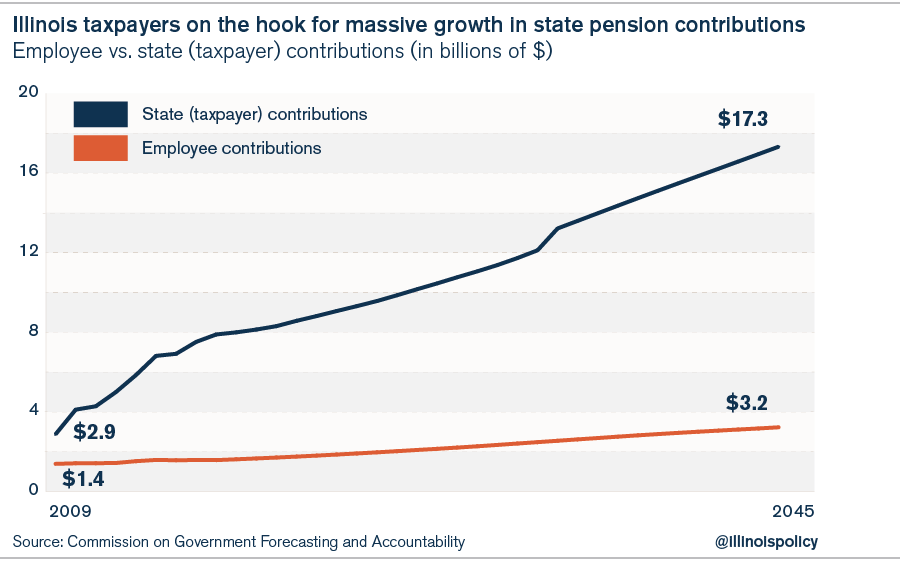
Why Illinois has a pension crisis
Illinois’ massive, growing, government-worker pension debt is a direct result of three major factors: overgenerous pension benefits, political manipulation and inherent flaws of pension plans.
1. Politicians grant workers overly generous pension benefits that taxpayers can no longer afford.
Government workers who earn generous pension benefits have done nothing wrong. They’ve benefited from labor negotiations that have led to lucrative compensation packages. However, the state’s taxpayers can no longer afford to offer such benefits going forward.
a. Retirement age: Private-sector workers cannot begin to collect full Social Security benefits until age 67. By contrast, 60 percent of state workers retire in their 50s, many of them with full benefits.
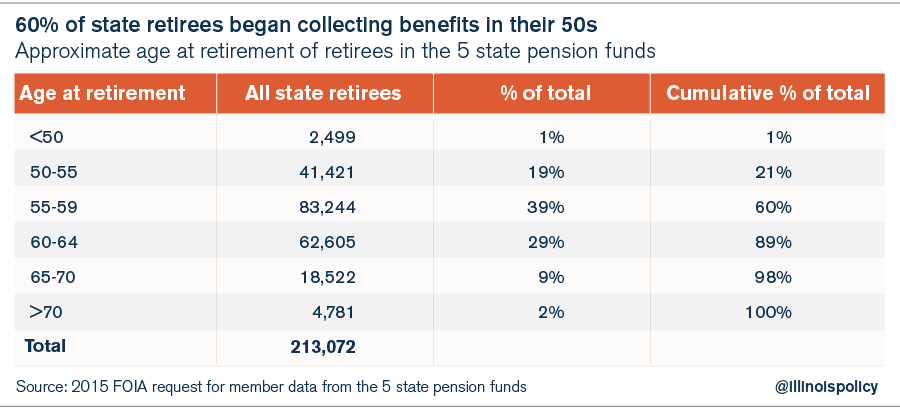
b. COLAs: Most retirees receive cost-of-living adjustments that are automatic, annual 3 percent compounded boosts to their pensions. That means their annual pension benefits will double in 25 years.
The state’s top pensioner, Leslie Heffez, earned a COLA of more than $16,000 in 2015, equal to the average annual Social Security payout for an average private-sector retiree. And since COLA benefits are not means-tested, Heffez will continue to receive COLA increases annually – which contributes mightily to his expected $18 million in lifetime pension benefits.
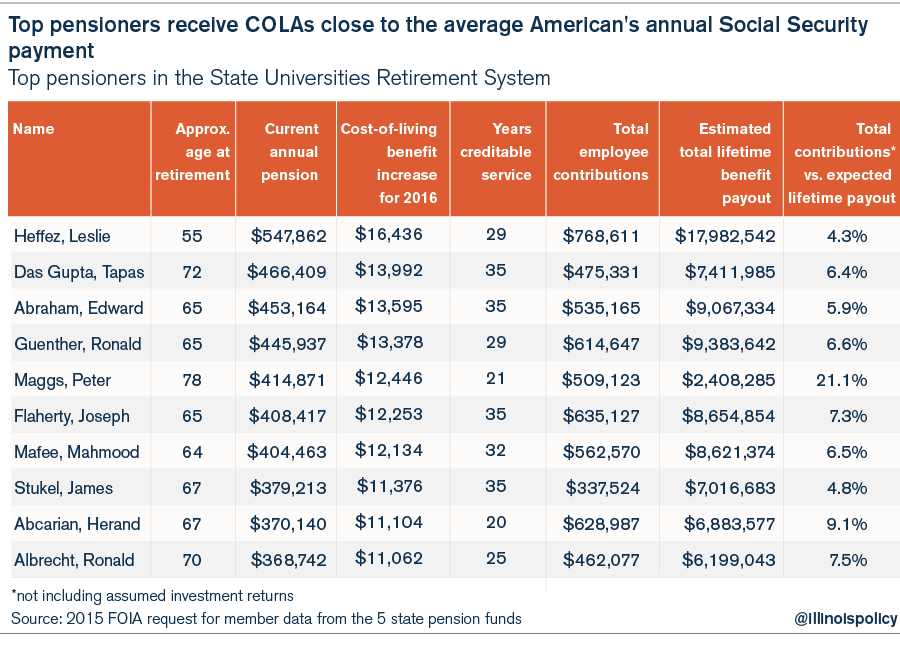
c. Contributions: Most retirees contribute only about 4 to 8 percent (8 to 16 percent when interest earned on investments is included) of what they receive in retirement benefits. For example, the average recently retired (from Jan. 1, 2013, through 2015) career (30 years of service) State Universities Retirement System member contributed only about $145,000 (6.5 percent) of the $2.2 million he or she will receive in lifetime retirement benefits.
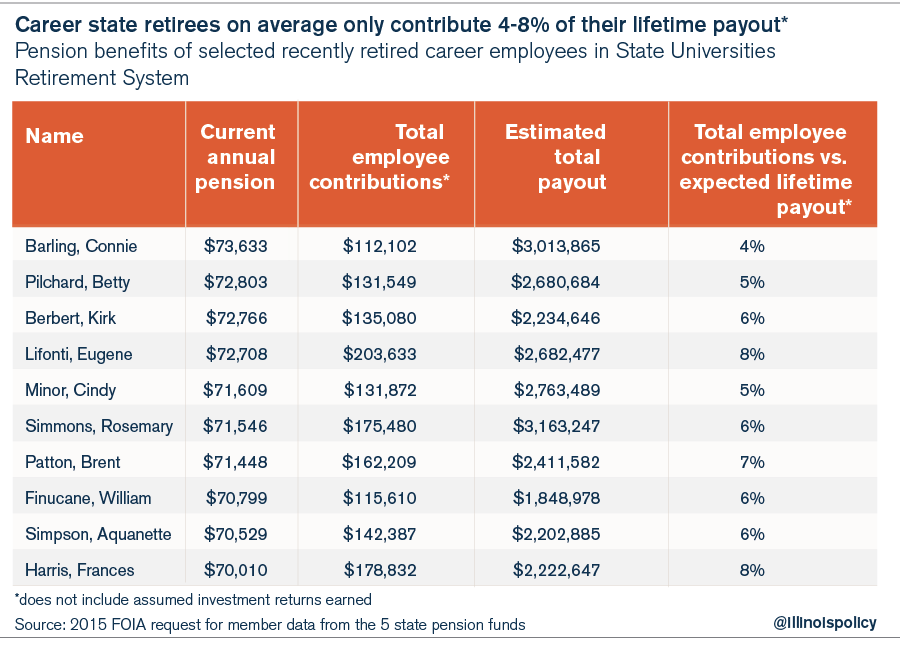
d. Payouts: The average career (30 years of service) teacher who retired recently (within the last three years) receives a $71,000 pension and will collect over $2 million over the course of her retirement. To generate similar benefits, a worker in the private sector would need to have more than $1.5 million in her bank account when she retires.
In all, 53 percent of the over 213,000 state retirees in Illinois can expect to receive lifetime pension benefits of more than $1 million. Almost 40,000 (18 percent of all retirees) will receive $2 million or more in benefits. By contrast, private-sector workers with average Social Security benefits will only receive approximately $400,000 in lifetime benefits.
e. Benefits in Chicago: Employees for the city of Chicago also receive generous pension benefits. Nearly half of all city workers retire before age 60, and recently retired career workers (30 years of service or more) receive $65,000 average annual pensions.
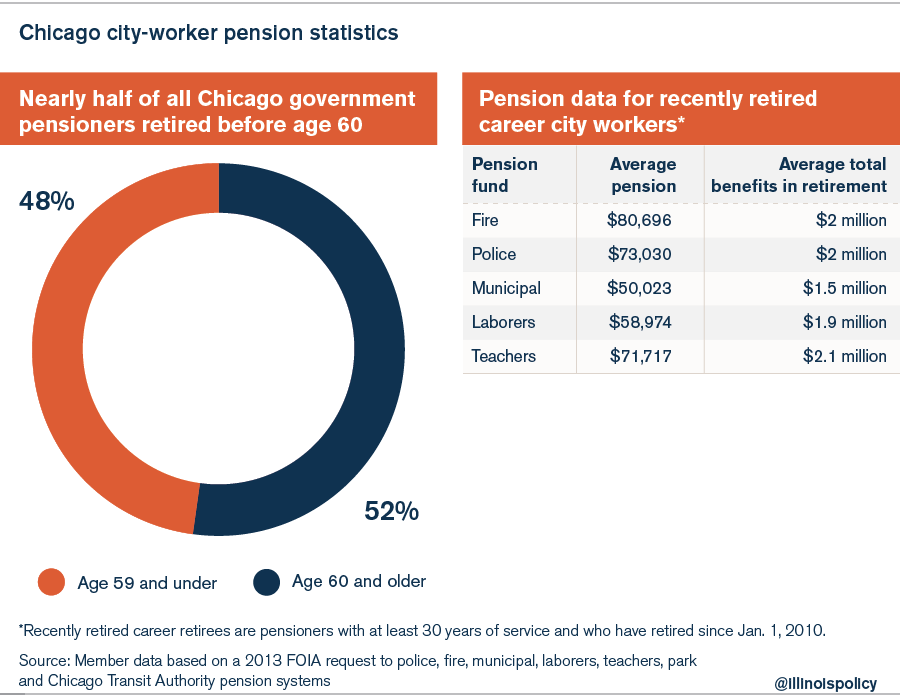
2. Politicians use pensions as a political slush fund. In 1994, Gov. Jim Edgar created a culture of kicking the can down the road when he enacted legislation that pushed state pension contributions far into the future – through 2045. Since then, Illinois politicians have borrowed, skipped payments and taxed to fund pensions rather than seek comprehensive reforms. As a result, the state’s 2015 pension shortfall has skyrocketed to $111 billion.
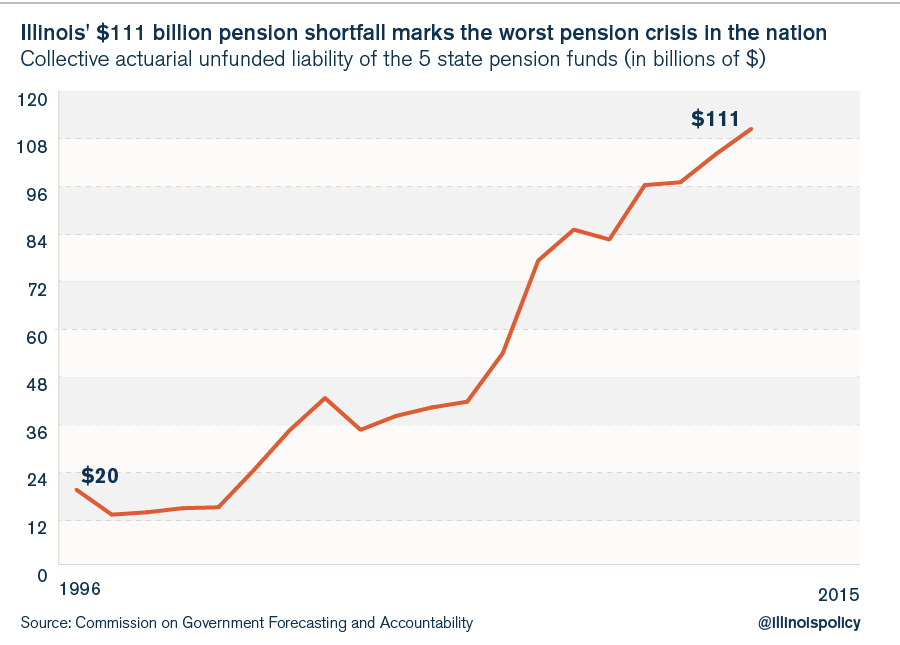
The current state of the Chicago teachers’ pension fund is the best example of how politicians manipulate pensions. Over the course of a decade, Chicago politicians redirected $3 billion in contributions away from the teachers’ pension fund, toward teachers’ salaries. Not only did this cause the teachers’ pension shortfall to skyrocket, but it also inflated teacher salaries, pushing teacher pension benefits to unaffordable levels.
The same thing also happened to Chicago’s police and firefighter pension funds. Police and firefighter salaries grew 50 to 70 percentage points faster than inflation over the past 30 years.
3. Pension plans are inherently flawed and unsustainable. Politicians’ failure to contribute to pensions is often blamed as the key reason Illinois pensions are so underfunded. However, that is not the case. A majority of the pension systems’ underfunding is due to the flaws inherent in DB plans. In DB plans, governments make promises to retirees based on certain assumptions – such as expected investment returns and mortality rates – which often fail. In all, 60 percent of the state’s current pension shortfall can be attributed to such failed assumptions.
The combination of these three factors has driven Illinois’ pension systems closer to insolvency. Chicago’s police and firefighters pension funds now have only a quarter of the money they need today to pay out future benefits. The Teachers’ Retirement System, the largest pension fund in the state, has less than half the money it needs. And at only 16 percent funded, the General Assembly’s own retirement system is the worst-off of all state funds, relying on a taxpayer bailout every year just to stay afloat.
Pensions and the Illinois budget
As Illinois’ pension funds fall farther into insolvency, the money needed to prop up the funds is growing far faster than Illinois’ budget. Pension costs already make up 25 percent of Illinois’ budget – a massive amount considering the average for other states is only 4 percent. Those costs have been crowding out funding for the state’s vital services.
For example, by 2025, the state will spend more of its education budget on teacher pensions than it will in the classroom. This will dramatically affect local school districts’ operational budgets – especially poorer districts with minority students that rely heavily on state funding.

Hi Bill,
Enjoyed the article. One might note that when the Illinois Legislature changed the Pension formula and the courts declared it unconstitutional Lisa Madigan appealed it to the Supreme Court of Illinois. The Supremes also declared it unconstitutional but Lisa never appealed to the U.S. Supreme Court. Neither did Chicago who also tried to change the pension formula. I wrote a letter to the editor asking why it was never appealed to the U.S. Supreme Court but it was never published. I think the U.S. Supremes might have read things differently than the Illinois Supremes who also have a State Pension Plan. Why would they rule to change the formula when their own pensions are on the line? The U.S. Supremes have no “skin in the game” so to speak and might have ruled that the changes were OK. Federal Law does provide for changes to pension plan formulae “going forward” but not backward.
1. Could you add in the years at the bottom of the graphs to better understand the disaster?
2. The debt listed is $111 as of 2015. Could you list the 2017 and estimated 2018 in actuarial values using a realistic rate of return on the pension contributions for investment such as 5% not 7 – 8%?
Data is not available as yet.